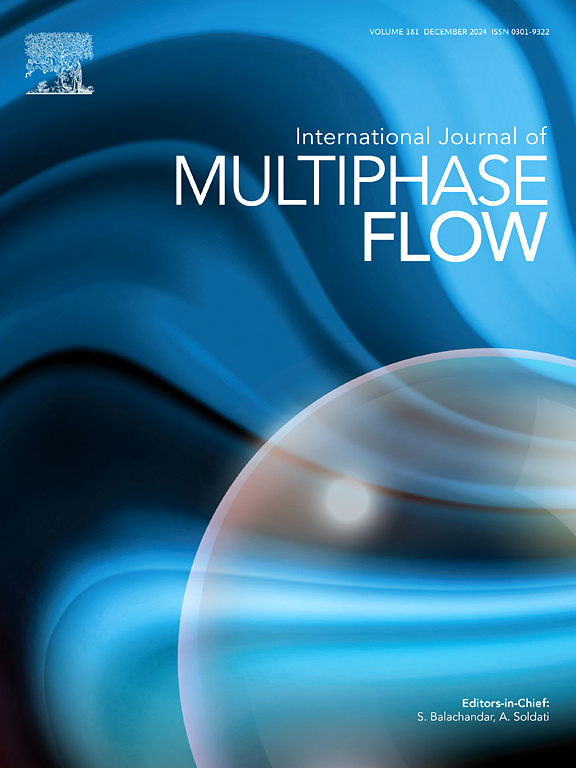Simulations for the interfacial waves in air-water annular flow in upward inclined tubes
IF 3.6
2区 工程技术
Q1 MECHANICS
International Journal of Multiphase Flow
Pub Date : 2025-03-26
DOI:10.1016/j.ijmultiphaseflow.2025.105228
引用次数: 0
Abstract
A numerical model is developed using the interIsoFoam solver within the OpenFOAM-v2106 framework to investigate gas-liquid two-phase annular flow in inclined tubes, with a specific focus on upward flow at five different inclination angles. The tube, which is 700 mm long with an inner diameter of 11.7 mm. The working fluid consists of air and water at atmospheric pressure, with the gas phase exhibiting a superficial velocity of 18 m/s, and the liquid film characterized by a liquid film Reynolds number (Ref) of 350. Near the inlet, high-frequency, low-amplitude initial waves are present. As the flow develops, these waves evolve into slower ripples at the top of the tube, particularly in the horizontal tube. Meanwhile, at the bottom, they transition into high-amplitude disturbance waves. This progression reflects the distinct evolution of wave types at the top and bottom as the flow progresses. The base liquid film thickness and interfacial wave amplitude in the inclined tube exhibit pronounced circumferential non-uniformity, with both decreasing gradually from the top to the bottom. This non-uniformity becomes more pronounced as the inclination angle decreases. An edge detection algorithm is used to identify the characteristic lines of ripple and disturbance waves, aiding in the investigation of circumferential wave velocity variations within the tube.

上斜管内空气-水环形流动界面波的模拟
利用OpenFOAM-v2106框架中的interIsoFoam求解器建立了一个数值模型,研究了倾斜管内气液两相环空流动,特别关注了五种不同倾角下的向上流动。该管长700毫米,内径11.7毫米。工作流体由常压下的空气和水组成,气相的表面速度为18 m/s,液膜的雷诺数为350。在入口附近,存在高频、低振幅的初始波。随着流动的发展,这些波在管的顶部演变成较慢的波纹,特别是在水平管中。同时,在底部,它们转变成高振幅的扰动波。这种变化反映了随着水流的发展,顶部和底部波浪类型的不同演变。基底液膜厚度和界面波振幅在斜管内表现出明显的周向非均匀性,从上到下逐渐减小。随着倾角的减小,这种不均匀性变得更加明显。利用边缘检测算法识别波纹波和扰动波的特征线,有助于研究管内的周向波速变化。
本文章由计算机程序翻译,如有差异,请以英文原文为准。
求助全文
约1分钟内获得全文
求助全文
来源期刊
CiteScore
7.30
自引率
10.50%
发文量
244
审稿时长
4 months
期刊介绍:
The International Journal of Multiphase Flow publishes analytical, numerical and experimental articles of lasting interest. The scope of the journal includes all aspects of mass, momentum and energy exchange phenomena among different phases such as occur in disperse flows, gas–liquid and liquid–liquid flows, flows in porous media, boiling, granular flows and others.
The journal publishes full papers, brief communications and conference announcements.

 求助内容:
求助内容: 应助结果提醒方式:
应助结果提醒方式:


